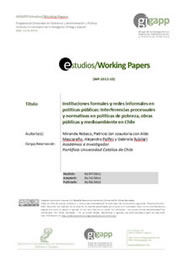Conflict and post-conflict from the Colombian territorial periphery
Abstract
The purpose of the following lines is to assert, as a research hypothesis, the peripheralization experienced by the Colombian armed conflict in recent years. As a consequence of the scope of the Democratic Security Policy and Plan Colombia, but also because of the particular impact of paramilitarism, a centrifugal tendency has been carried out in terms of public security but also of the violence derived from the armed conflict. This peripherialization poses an important challenge to the Colombian State, above all, because a hypothetical deactivation of the conflict with the FARC, and possibly with the ELN, within the current dialogues of Havana, will only be possible if it is advocated to overcome certain structural conditions of violence that, today, continue to be unresolved. In the absence of this circumstance, the sense of peace in Colombia may remain limited and confers on a significant part of its territory a logic in which the presence of irregular armed groups and the violent translation that this implies continues to be a constant away from any hint of overcoming.
Downloads
Copyright (c) 2017 Jerónimo Ríos Sierra

This work is licensed under a Creative Commons Attribution-NonCommercial-ShareAlike 4.0 International License.
Those authors who have publications with this journal, accept the following terms:
a. Authors will retain their copyrights and guarantee the journal the right of first publication of their work, which will be simultaneously subject to the Creative Commons Attribution-NonCommercial-ShareAlike 4.0 International (CC BY-NC-SA Recognition License). 4.0) that allows third parties to share the work as long as its author and its first publication are indicated in this journal.
Under this open access license, readers (users) can:
- Share — copy and redistribute the material in any medium or format
- Adapt — remix, transform, and build upon the material
Under the following terms:
-
Attribution — Users must give appropriate credit, provide a link to the license, and indicate if changes were made. You may do so in any reasonable manner, but not in any way that suggests the licensor endorses you or your use.
-
NonCommercial — Users may not use the material for commercial purposes.
-
ShareAlike — If remix, transform, or build upon the material, users must distribute your contributions under the same license as the original.
- No additional restrictions — Users may not apply legal terms or technological measures that legally restrict others from doing anything the license permits.
b. Authors may adopt other non-exclusive license agreements for the distribution of the version of the published work (eg: deposit it in an institutional telematic archive or publish it in a monographic volume) provided that the initial publication in this journal is indicated.
c. Authors are allowed and recommended to disseminate their work through the Internet (e.g. in institutional telematic files or on their website) before and during the submission process, which can lead to interesting exchanges and increase citations of the published work. (See The effects of open access).



